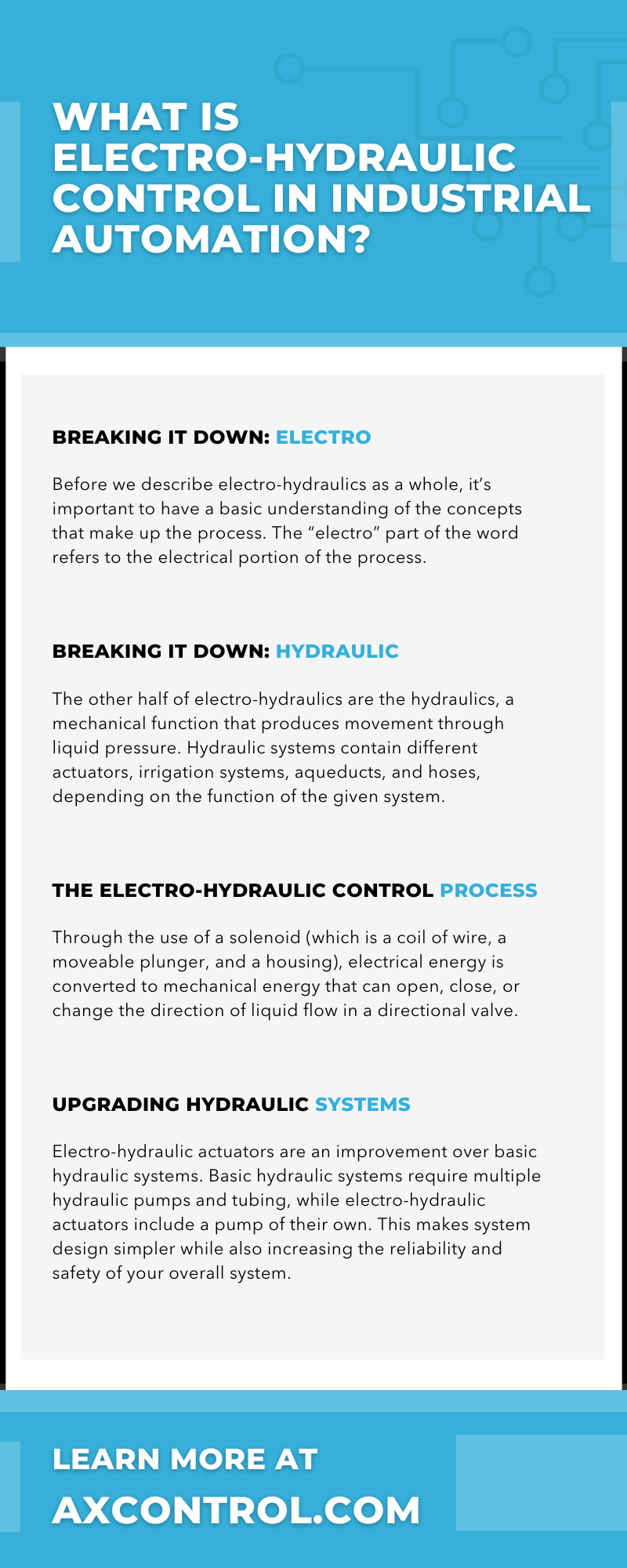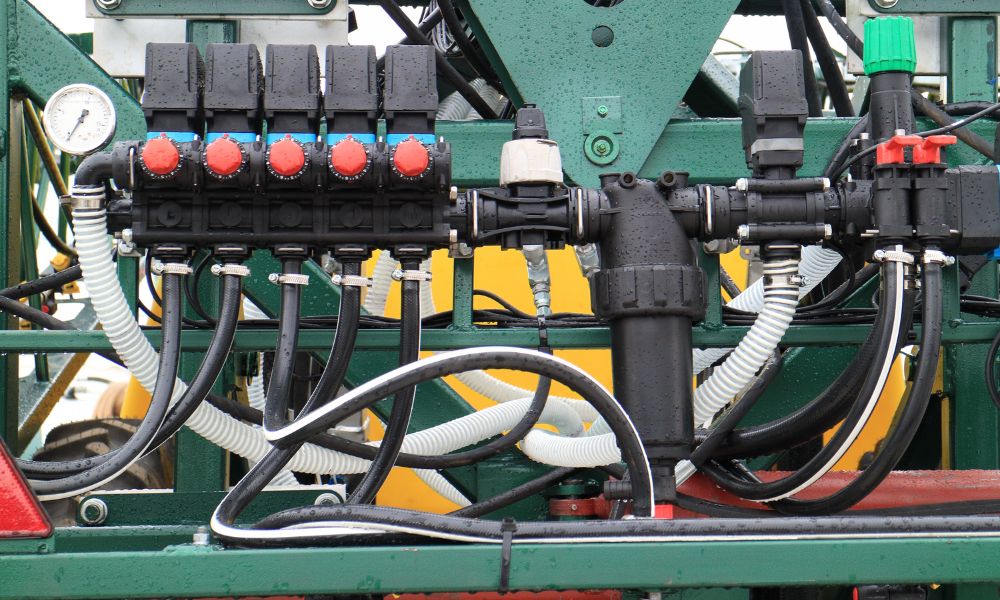Industrial automation is a field with tons of different processes and technologies—one of the most useful of which is electro-hydraulics. While this concept is fascinating on its own, electro-hydraulics are useless without a way to control them. We’re going to dive deeper into electro-hydraulic control in industrial automation, as well as take a look at how electro-hydraulics are useful in a variety of facilities and applications.
Breaking It Down: Electro
Before we describe electro-hydraulics as a whole, it’s important to have a basic understanding of the concepts that make up the process. The “electro” part of the word refers to the electrical portion of the process. In the case of electro-hydraulics, this electricity is used to send signals to various parts of the drive in order to instruct other areas to carry out given tasks.
Breaking It Down: Hydraulic
The other half of electro-hydraulics are the hydraulics, a mechanical function that produces movement through liquid pressure. Hydraulic systems contain different actuators, irrigation systems, aqueducts, and hoses, depending on the function of the given system. You’ll most commonly see hydraulics show up in automotive braking and power steering, but it’s an essential function in industrial automation, too.
When we’re discussing electro-hydraulics, this part of the system is used for its adjustable hydraulic valves that open and close.
The Electro-Hydraulic Control Process
When we put those unique halves together, we gain a better understanding of how the entire electro-hydraulic process works. Through the use of a solenoid (which is a coil of wire, a moveable plunger, and a housing), electrical energy is converted to mechanical energy that can open, close, or change the direction of liquid flow in a directional valve.
Electrical signals are sent to the solenoid, directing it to open, close, or change direction. Also at work in the valve are chambers known as ports. When the solenoid slides a spool inside the valve, different ports open or close. When liquid is blocked or allowed to flow, you can achieve different mechanical results in your system.
All of this would not be possible without signal processing, which is done through electrical signals on a computer. When you have continuously adjustable valves and proportional valves, you can constantly adjust set points for increased process compensation.
Upgrading Hydraulic Systems
Electro-hydraulic actuators are an improvement over basic hydraulic systems. Basic hydraulic systems require multiple hydraulic pumps and tubing, while electro-hydraulic actuators include a pump of their own. This makes system design simpler while also increasing the reliability and safety of your overall system.
Benefits of Using Electro-Hydraulic Control
Now that you have a solid understanding of the inner workings of an electro-hydraulic system, let’s explore the benefits of using one in your facility or industry. For one thing, the efficiency upgrade from traditional hydraulic systems is substantial. Depending on what you will use your electro-hydraulic system for, you may be able to see an increase in efficiency of up to 80 percent.
The reason for this sweeping change is the electro-hydraulic motor’s power-on-demand capabilities. Your motor will use no energy when it is not specifically needed, which can significantly reduce the amount of energy waste in your facility. This leads to a secondary benefit in the form of an increased component lifespan. When you don’t need to think about the engine and pump idling, bearings and seals will naturally last longer.
One other major benefit is the simplicity of the pump controls. Because of its unique design, signals only need to tell the pump information about speed and motor direction, as opposed to multiple proportional and directional values. Reduced complexity means that addressing problems when things go wrong becomes a much simpler situation.
Electro-hydraulic actuators can additionally be used in some instances that surpass the capacity of traditional hydraulics, as they can handle up to a 4,800-pound load. Despite this increased capacity, electro-hydraulic actuators are quieter than traditional hydraulic actuators, which may be an additional benefit in certain situations.
Finally, the size and availability of electro-hydraulic motors is a large advantage. Because these require a high-energy battery pack as opposed to a gas engine, an electro-hydraulic unit has far more versatility. When engineers don’t need to place a given component near others, it affords them greater design creativity and leads to a better final product.
Thankfully, the price of these units is also falling as more and more companies begin to develop parts and components. For instance, we have all the parts you need for the Mark V DS200 in stock now.
Drawbacks of Using Electro-Hydraulic Control
Of course, no technology is without its share of drawbacks. We want to make sure you understand the full picture of the technology you’re using before you make a decision. One of the biggest problems with electro-hydraulics is their perception. It was only a few short years ago that these devices were avoided because they caused more problems than they solved.
Upon their first introduction, electro-hydraulic actuators were much weaker and more unreliable than traditional hydraulic actuators. In the ensuing years, they have grown far more powerful and more dependable than traditional actuators.
However, electro-hydraulic actuators do still carry a higher upfront cost than their traditional counterparts. You’ll feel this financial factor more when you need to install multiple units, but it’s important to note that this is a high initial cost. In time, through efficiency savings and maintenance savings, electro-hydraulic actuators become good value and pay off.
The other issue is that while electro-hydraulic actuators come with reduced maintenance, that doesn’t mean they require nomaintenance at all. When something goes wrong, it’s important to have a specialist that can come in and fix the problem, as your average repair worker will likely be unable to address the issue.
Now that you know what electro-hydraulic control in industrial automation is, remember that AX Control can help you find the parts you need for your electro-hydraulic control system or any number of other industrial machines! We always provide competitive quotes on parts and repairs, so be sure to check with us first when you need parts for industrial automation. Contact our team today to learn more!



You must be logged in to post a comment.